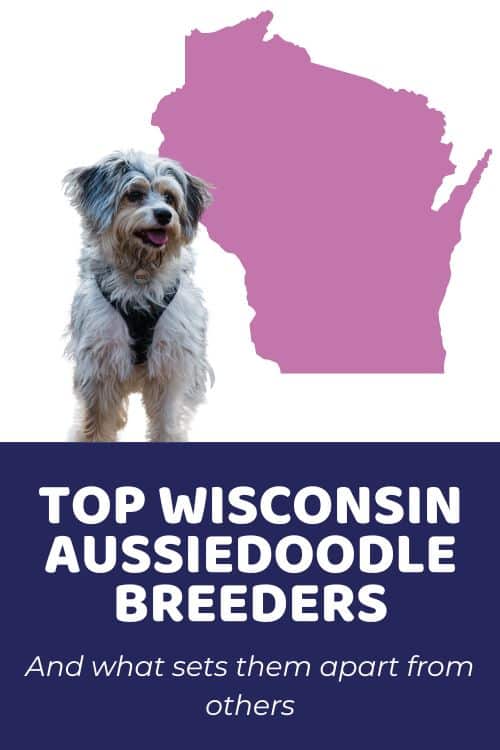Gorgeous, bright, and family-friendly to boot, both Aussiedoodles and Bernedoodles are perfect companion dogs. However, a few crucial differences between the two make them better suited to one environment over another; picking out a pooch that matches your family situation and lifestyle is important. That’s why we have compiled a complete rundown of these two fab Doodles. Here we cover everything from looks, temperament, and size to exercise needs to ensure you find the perfect pup for you.

All About Aussiedoodles
A unique blend of super-smart Poodle and super-motivated Australian Shepherd, Aussiedoodles are beautiful, intelligent, and very active dogs. They were likely intentionally bred for the first time in North America in the late 1990s or early 2000s.
Selected for Doodling because of their unique color combinations as much as for their temperament, Australian Shepherds are working dogs at heart. Despite their name, they originate from the US. However, Australian-imported dogs were used in the creation of the breed. Today these eye-catching pups are still used in herding but make pretty popular pets too.
Poodles add even more energy, intelligence, and color combinations to the mix. Also working dogs, but bred for retrieving over herding, Poodles are surprisingly athletic underneath all that glorious floof. Speaking of hair, they also bring in the possibility of the highly-prized so-called hypoallergenic, non-shed coat. There are just so many wins with this breed combination.
All About Bernedoodles
Bernedoodles are one of the most well-known types of Doodle, making it easy to get your hands on one from a local breeder. These sweet dogs combine the larger-sized Bernese Mountain Dog and (most often) the Standard Poodle. However, as generations progress, pint-sized versions of these Doodles are becoming increasingly available.
Known for their calm, kid-friendly temperament in spite of their size, Bernese Mountain Dogs make great family dogs for those who have the space to accommodate them. Originally bred as draft animals up in the Swiss farmlands, they are strong yet willing and effortless to train, which only adds to their appeal.
The addition of the Poodle genes here gives these dogs a little more bounce than the otherwise extremely laid-back Bernese would have. It also picks up the intelligence levels, reduces the size (sometimes considerably), and raises the chances of a low-shed coat. It’s all this and more that makes these dogs so desirable as pets.
Aussiedoodle vs Bernedoodle: Size
With Bernese Mountain dogs being a large breed and Australian Shepherds a medium one, it’s really no surprise that Bernedoodles are larger than Aussiedoodles.
This is true across every variety, as can be seen below:
| Aussiedoodle | Bernedoodle | |
| Tiny/Toy | Weight: 10-15 pounds Height: 10 inches or less | Weight: 10-25 pounds Height: 17 inches or less |
| Miniature | N/A | Weight: 25-35 pounds Height: 18-23 inches |
| Medium | Weight: 15-45 pounds Height: 10-15 inches | Weight: 35-55 pounds Height: 24-26 inches |
| Standard | Weight: 45-70 pounds Height: 15+ inches | Weight: 60-90 pounds Height: 27-29 inches |
Male dogs also tend to be larger than female ones for both types of Doods, but the difference isn’t usually all that significant.
Aussiedoodle vs Bernedoodle: Temperament
This is where key differences between Aussiedoodles and Bernedoodles start to come into play. While both are excellent family dogs, loving and loyal, goofy and fun, Aussiedoodles are much more excitable than their calmer compadres. Their boundless energy and natural exuberance mean they are always on the go – ever ready for the next adventure.
Aussies can also be a little on the bossy side, depending on how much of the herding instincts they inherit from their Shepherd ancestors. They were literally bred to push others around. However, these super-intelligent dogs can easily be trained out of such pesky traits (more on this below).
Bernese Mountain Dogs, on the other hand, are calm and easygoing. This is something Bernedoodles often inherit. It makes them great around even small children who might be overwhelmed by the Aussiedoodle’s fast-paced energy. They are also extremely caring and sensitive pups who love to take care of their family.
This devotion can, however, also cause issues. Bernedoodles are prone to suffering from separation anxiety if left home alone for extended periods. Plus, their commitment to their family coupled with their innate guarding instincts can make them overly cautious of strangers and unfamiliar situations. They require thorough socialization to prevent this from being the case.
Bernedoodle vs Aussiedoodle: Appearance
All Doodles tend to have a fairly distinctive Poodle-y appearance that gives them that cute, teddy bear look that they are known for. The Poodle genes also carry an assortment of colors that these dogs happily pass on to their Doodle offspring. However, Bernies and Aussies often inherit the stunning tri or multi-colored coats of their other parent dogs.
Bernedoodles are commonly black and white with brown or ‘rust’ touches. However, they can also have a dominant russet color in place of the black. Aussiedoodles might have a red or blue merle coat. They could also be black and red, black and tan, parti, sable, or even, in rare cases, a solid color.

Aussiedoodle vs Bernedoodle: Grooming & Maintenance
Both Bernese Mountain Dogs and Australian Shepherds have thick, straight double coats. This is a world away from single-layer, curly Poodle hair. Therefore, predicting what type of coat either Doodle will have – especially a first-generation one – can be tricky.
Bernedoodles and Aussiedoodles could end up with any one of the following:
A thick, long straight coat (Straight Coat)
Common only to first-generation Doods, this coat is easy to brush and less likely to form knots. Chances are, though, if your pet has inherited this coat, they will be more likely to shed. Therefore, regular grooming is required to ensure you don’t end up with a layer of hair across your carpet and everything else in your house.

A dense, short, wiry coat (Curly/Wool Coat)
A curly coat is more probable in progressive generations as these dogs have more Poodle genes. This is the highly desirable low-shed hair. However, that doesn’t mean it’s effortless to care for – quite the reverse, in fact. Poodle coats are incredibly prone to knots, tangles, and mats and, for this reason, dogs with this type of hair require daily brushing to ensure this problem doesn’t get out of hand.
A wavy, shaggy mix of the two (Fleece Coat)
Probably the most common Doodle coat type. The wavy coat is longer than the curly one but luckily also less tangle-happy. This means that dogs with this hair don’t need to be brushed quite as often. Luckily, they are generally pretty low shed too. For this reason, this is the easiest coat to maintain. You just might need to take your shaggy-haired pup for regular trims as it can get a little scruffy looking if left to grow out too much.
Bernedoodle vs Aussiedoodle: Health & Wellness
Probably one of the best things about Doodle (aside from their cuteness and low shed coat) is their super-duper health. Hybrid vigor dictates that mixed breed dogs are healthier than their purebred counterparts because the wider gene pool makes inherited conditions much less likely.
While less likely, genetic diseases and health conditions are sadly not wholly eradicated.
Bernedoodles can be at risk of ocular diseases, allergies, and elbow and hip dysplasia. On occasion, they can suffer from skin issues such as hot spots because of their thick coats. They are also prone to rapid weight gain without a carefully controlled diet and plenty of exercise.
Aussiedoodles a susceptible to developing cataracts, hip dysplasia, autoimmune thyroiditis, sebaceous adenitis, and progressive retinal atrophy during their lifetime. Their love of exercise, however, makes them less likely to pack on the pounds.
Whichever Dood you opt for, be sure to purchase them from a reputable breeder. With careful genetic screening, many of the conditions listed above are absolutely avoidable.
Bernedoodle vs Aussiedoodle: Lifespan
All that vigorous health that Doodles enjoy also happily makes for a longer lifespan.
As with all breeds, smaller dogs tend to outlive older ones – that’s the canine rule. Meaning, toy and medium Doodles will generally be around a bit longer than standard ones.
Both Bernedoodles and Aussiedoodles have a life expectancy of 12-18 years. However, as the Standard Aussiedoodle can be quite a bit smaller than the Standard Bernedoodle, they may outlive larger Standard Bernedoodles by a year of few.
Aussiedoodle vs Bernedoodle: Training & Environment
The good news is that Poodle smarts make teaching new commands reasonably effortless. So, Aussiedoodles and Bernedoodles are highly trainable. Plus, the fact that their parent dogs are all working animals makes them highly motivated to learn.
In fact, both types need a significant amount of mental stimulation alongside plenty of physical exercise to prevent them from getting bored and to stop them from getting into trouble. So, you might want to go a little above and beyond the usual sit, stay, high-five routine.
Aussiedoodles especially, with all that energy to spare, benefit from canine sports where they get to use both body and brain. Bernedoodles, on the other hand, need a little more socialization because of their more cautious nature. So plenty of walks in new places and time spent with other dogs, people, and animals is a must for these guys.
A word of caution. Even though both dogs are very trainable doesn’t necessarily mean that it’s always easy. Bernedoodles have wonderful people-pleasing personalities. However, being at the larger end of the size spectrum, they are pretty powerful dogs. They can get a bit stubborn and difficult if they decide they are not having a good time. Aussiedoodles, as herding dogs, are used to be in control. They require a firm and consistent hand and can easily run rings around less confident owners.
Newbie dog owners and people who don’t have a great deal of experience with training working dogs might struggle with handling these clever canines. If this is you, then it’s crucial to do as much research as you can. Start with our dedicated article Obedience Training for Dogs: Mastering the Basics.
Aussiedoodle vs Bernedoodle: Cost
Doodles are a designer breed which means that they can be a little on the expensive side. This is undoubtedly the case for both Bernies and Aussies.
Bernedoodles, as the more popular option currently, cost a little bit more at $2,000 to $5,000 a puppy. Aussiedoodles go for around $1,500 to $4,000 a puppy.
Beyond the initial purchase price, you also need to factor in food, accessories, vet bills, and more. Some people opt to take their pet to the groomer on a regular basis rather than dealing daily with their coat themselves. This is an expense that can quickly add up.
If you prefer to take care of your pup’s coat at home, we have plenty of super useful home grooming instructional articles to help you do just that.
Aussiedoodle vs Bernedoodle: Family Friendliness
As we’ve already mentioned a couple of times, both Doodles make great family pets. They really do. That’s why more and more people are looking to welcome these types of dogs into their home. However, there are a couple of things you are going to want to consider:
Aussiedoodles, with their more animated character, might be a little much for smaller children. They also tend to be a little more dominant and could end up herding family members about the house with bumping and some light nipping. For this reason, Aussies are more suited to a household with older children and teens. They will love the energy and all the opportunities for walks and games.
Bernedoodles, while larger, are much more laid back. This makes them great around smaller children. In fact, we recently conducted a survey of current Doodle owners, and Bernies were consistently ranked as excellent family dogs. That being said, you should never leave children unsupervised around any dogs or other animals.
Aussiedoodle vs Bernedoodle: Which is the Puppy for You?
We get it; Aussies and Bernies are both great dogs. As Doodles, how could they not be? They each make excellent companion animals for the right type of family situation.
Opt for an Aussiedoodle if:
- You are an active, outdoorsy person looking for a hiking buddy
- Have older children and teenagers who would love a dog to play with
- Live in a house with a lovely big garden for games
- Are interested in learning more about agility training and canine sports
- Have a slightly lower budget
Opt for a Bernedoodle if:
- You’re looking for a fun dog who you can cuddle up on the couch with
- Have younger or quieter children who would love a dog to spend time with
- Live in a house or apartment with a smaller outdoor area
- Have experience training larger and/or working dogs
- Are happy to spend a little more on the perfect puppy
Picking out the right dog for your family goes a little beyond selecting the one you like the look of. With so many types of Doodle available these days, it can be easy to get bogged down in the details. Hopefully, reading through this article has helped highlight a few key aspects of the Aussie and Bernedoodles to help you differentiate between the two and decide which would best suit you and your family.
Learn Which Doodle Is Best For You!

Avoid making the mistake of choosing the wrong Doodle temperament for your family, lifestyle, or current living situation.
Learn More











